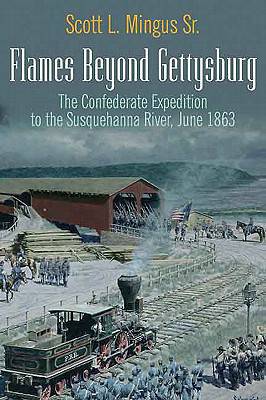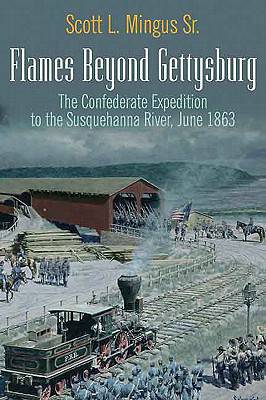
- Afhalen na 1 uur in een winkel met voorraad
- Gratis thuislevering in België vanaf € 30
- Ruim aanbod met 7 miljoen producten
- Afhalen na 1 uur in een winkel met voorraad
- Gratis thuislevering in België vanaf € 30
- Ruim aanbod met 7 miljoen producten
Zoeken
Flames Beyond Gettysburg
The Confederate Expedition to the Susquehanna River, June 1863
Scott L Mingus
Paperback | Engels
€ 16,95
+ 33 punten
Omschrijving
The Gettysburg Campaign has been examined in minute detail from nearly every aspect but one: the key role played by Richard Ewell's Second Corps during the final days in June. Scott Mingus's Flames Beyond Gettysburg: The Confederate Expedition to the Susquehanna River, June 1863 is the first in-depth study of these crucial summer days that not only shaped the course of the Gettysburg Campaign, but altered the course of our nation's history. In two powerful columns, Ewell's Corps swept toward the strategically important Susquehanna River and the Pennsylvania capital looming beyond. Fear coursed through the local populace while Washington and Harrisburg scrambled to meet the threat. One of Ewell's columns included a veteran division under Jubal Early, whose objectives included the capture and ransom of towns and the destruction of railroad bridges and the Hanover Junction rail yard. Early's most vital mission was the seizure of the Columbia Bridge, which spanned the Susquehanna River between Wrightsville and Columbia. To capture the longest covered bridge in the world would allow Early's Division to cross into prosperous Lancaster County and move against the capital in Harrisburg from its relatively undefended rear. Along the way, one of Early's brigades under John Gordon occupied Gettysburg and spilled the first blood there days before the bloodiest battle ever fought on American soil began on July 1. Flames Beyond Gettysburg vividly narrates both sides of Ewell's drama-filled expedition, including key Southern decisions, the response of the Pennsylvania militiamen and civilians who opposed the Confederates, and the burning of the Columbia Bridge. Mingus's study also features detailed driving tours of the various sites discussed in the book, including the Confederate route of march from Maryland; the June 26 skirmish at Gettysburg and the fight at the Witmer Farm; Lt. Col. Elijah V. White's cavalry raids on Point-of-Rocks and Hanover Junction; Gordon's triumphal march through York; the skirmish at Wrightsville; and the bridge burning. Based upon extensive primary source material and featuring original maps by cartographer Steven Stanley, the fast-paced and gracefully written Flames Beyond Gettysburg is a welcomed and important addition to the Gettysburg literature. About the Author: Scott L. Mingus, Sr. is a scientist and executive in the paper and printing industry. He maintains a popular blog on the Civil War history of his home of York County, PA, for the York Daily Record (www.yorkblog.com/cannonball), and is a sanctioned Civil War tour guide for the York County Heritage Trust. Scott is the author of five scenario books on wargaming and together with his wife Debi, publishes CHARGE!, the leading international magazine for Civil War miniature wargaming.
Specificaties
Betrokkenen
- Auteur(s):
- Uitgeverij:
Inhoud
- Aantal bladzijden:
- 312
- Taal:
- Engels
Eigenschappen
- Productcode (EAN):
- 9781611210729
- Verschijningsdatum:
- 11/02/2011
- Uitvoering:
- Paperback
- Formaat:
- Trade paperback (VS)
- Afmetingen:
- 150 mm x 226 mm
- Gewicht:
- 539 g

Alleen bij Standaard Boekhandel
+ 33 punten op je klantenkaart van Standaard Boekhandel
Beoordelingen
We publiceren alleen reviews die voldoen aan de voorwaarden voor reviews. Bekijk onze voorwaarden voor reviews.











